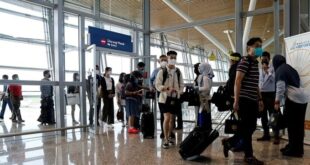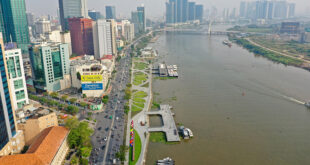Will Vietnam’s tourism see a boost soon? Industry insiders are optimistic about future prospects as the government weighs up a 90-day e-visa to gain a competitive edge as a leading tourism destination.
Travel companies are anticipating that if the decision is finalized in the ongoing National Assembly’s meeting, which started on Monday, the sector could take advantage of the change right from the traveling season starting in September and achieve the goal of eight million foreign tourists for this year.
As of the end of April, Vietnam has welcomed nearly 3.7 million international arrivals, reaching nearly half of the goal it has set for 2023.
However, these figures hint that Vietnam’s tourism rebound is still underway – the 2023 goal is modest compared to the country’s record 18 million international arrivals in 2019.
Pham Ha, CEO of travel business Lux Group, told Vietnam News: “Open policies like this will be a driving force for tourism. I believe that with other comprehensive policies, Vietnam can receive eight million foreign visitors within the year 2023.”
The visa validity extension has been a long-awaited decision for many travel agencies, as it allows easier, longer stay in Vietnam and, therefore, more economic revenue, Ha added.
Le Hong Thai, CEO of Hanoitourist, said: “Statistics revealed that international tourists’ spending is around 11 times more than that of domestic.
“It means that even if we have 100 million local tourists, it still will not bring in as much as the goal we have set out for this year, which is eight million.”
While these numbers are only comparative, the difference is evident, he said.
“This is why more favorable conditions are needed and why we have to attract international tourists to Vietnam now,” said Thai.
The 90-day visa, however, is expected to go beyond catering to foreigners looking for an extended tropical getaway.
Thai believed that Vietnam can position itself as a main transit point to its advantage, especially when tourists plan to visit multiple countries in the region.
This is where the extended visa – single or multiple-entry – plays an important role.
He said: “Korean tourists, for example, will arrive here [in Hanoi] for a few days, then they go to Da Nang, and then they fly to Siem Reap (Cambodia). After two or three days in Siem Reap, they will return to Vietnam to fly back to the Republic of Korea.”
“In this case, if their visa is single-entry then it is not possible. But if we issue multiple-entry visas, they can arrive and return to Vietnam multiple times within 90 days, which is a major advantage.”
The same could also be said for European tourists, Thai added.
“For instance, French or U.K. tourists come here and also want to visit Laos and Cambodia, but there’s no direct flight back home from those locations, so they will return to Vietnam,” he said.
However, many concerns have been raised about whether people will take advantage of this visa policy for purposes other than traveling.
“Many experts have posed this question, and I believe that the answer lies in the registration form that international arrivals have to fill in when they want to apply for a visa to Vietnam.”
The document requires stating the purpose of the visit, whether it’s tourism, business, visiting relatives or other.
This is what state management agencies and officers can base on for review and monitoring.
“I think that when state management agencies strengthen their inspection and supervision, this [visa] policy is definitely possible,” said Thai.
“The result we want to achieve is to promote the development of our tourism sector compared with other countries in the Southeast Asian region.”
In a report addressing these concerns on May 16, Minister of Public Security To Lam said that e-visa issuance is conducted through pre-approval of personnel.
Therefore, the policy responds to management demands by helping immigration offices screen people who do not meet the requirements for entry.
While the 90-day visa proposal is collectively viewed as a boost for the sector, industry experts believe that the policy alone will not be able to transform the entire tourism landscape.
Phung Quang Thang, Vice Chairman of the Vietnam Society of Travel Agents (VISTA), said: “How each country’s destination recovers [post-Covid] depends on its existing conditions.”
“During their trip, tourists will need a lot of public services,” Thang said. “But obviously, the infrastructure is in different levels of development in each country.”
The number of arrivals will increase with favorable visa policies, but achieving the set goal for tourism concerns many other factors, such as new and unique tourism products and easier access to locations, he said.
“Tourists must have a great experience during their extended stay in Vietnam, and the goal we aim at is that when they return home, they will introduce Vietnam to their families and friends and especially feel the need to travel to Vietnam again.”
- Reduce Hair Loss with PURA D’OR Gold Label Shampoo
- Castor Oil Has Made a “Huge” Difference With Hair and Brow Growth
- Excessive hair loss in men: Signs of illness that cannot be subjective
- Dịch Vụ SEO Website ở Los Angeles, CA: đưa trang web doanh nghiệp bạn lên top Google
- Nails Salon Sierra Madre
 VnExpress News The News Gateway of Vietnam
VnExpress News The News Gateway of Vietnam



